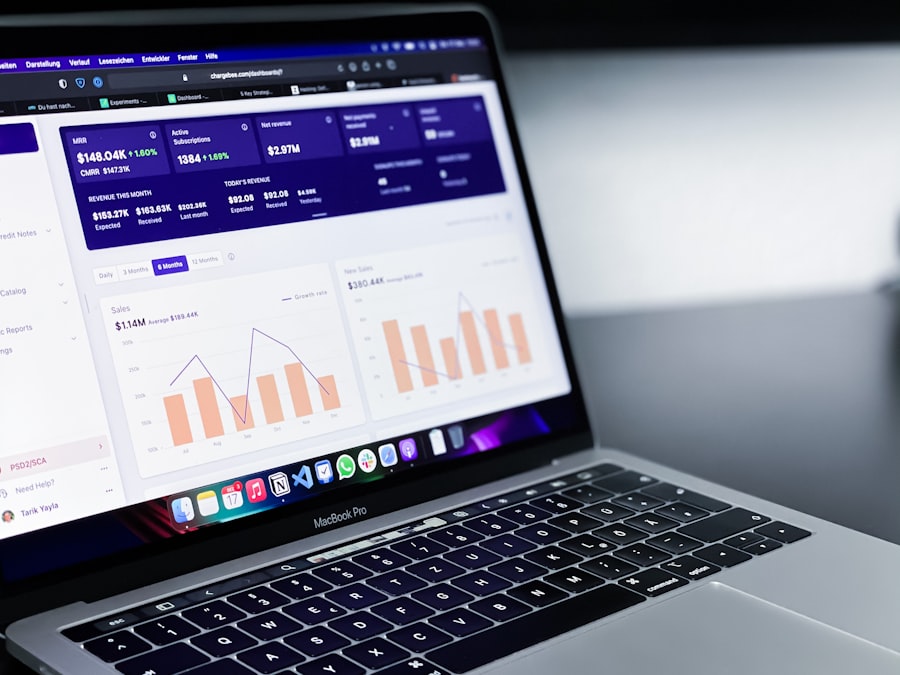Search Engine Optimization (SEO) is a multifaceted digital marketing strategy aimed at enhancing a website’s visibility in search engine results pages (SERPs). At its core, SEO involves optimizing various elements of a website to ensure that it ranks higher for relevant search queries. This process is crucial because the majority of online experiences begin with a search engine, and users tend to click on the top results.
Therefore, understanding the fundamentals of SEO is essential for anyone looking to improve their online presence. The primary goal of SEO is to attract organic traffic, which refers to visitors who arrive at a website through unpaid search results. This is achieved by aligning a website’s content and structure with the algorithms used by search engines like Google, Bing, and Yahoo.
These algorithms consider numerous factors, including relevance, authority, and user experience. By grasping these basic principles, businesses and individuals can develop effective strategies to enhance their visibility and drive more traffic to their sites.
Key Takeaways
- SEO fundamentals are essential for improving website visibility and ranking.
- Effective keyword research guides targeted content creation and optimization.
- On-page and off-page techniques work together to enhance search engine rankings.
- High-quality content and social media engagement boost SEO success.
- Regular performance analysis and staying current with SEO trends ensure ongoing improvement.
Keyword Research and Analysis
Keyword research is the cornerstone of any successful SEO strategy. It involves identifying the terms and phrases that potential customers use when searching for products or services related to a business. This process not only helps in understanding user intent but also guides content creation and optimization efforts.
Tools such as Google Keyword Planner, SEMrush, and Ahrefs can provide valuable insights into search volume, competition, and related keywords, enabling marketers to make informed decisions. Once relevant keywords are identified, the next step is to analyze their potential impact on SEO efforts. This includes assessing the competitiveness of each keyword and determining which ones are most likely to drive traffic.
Long-tail keywords, which are typically longer and more specific phrases, often present less competition and can yield higher conversion rates. For instance, instead of targeting a broad keyword like “shoes,” a business might focus on “women’s running shoes for flat feet.” This targeted approach not only improves the chances of ranking higher but also attracts a more relevant audience.
On-Page Optimization Techniques

On-page optimization refers to the practices implemented directly on a website to improve its search engine rankings. This includes optimizing individual web pages for specific keywords, enhancing user experience, and ensuring that content is structured in a way that search engines can easily understand. Key elements of on-page optimization include title tags, meta descriptions, header tags, and URL structures.
Title tags are one of the most critical components of on-page SEO. They should be concise, descriptive, and include the primary keyword for the page. Similarly, meta descriptions provide a brief summary of the page’s content and should also incorporate relevant keywords to entice users to click through from the SERPs.
Header tags (H1, H2, H3) help organize content hierarchically, making it easier for both users and search engines to navigate the information presented. Additionally, creating SEO-friendly URLs that are short and descriptive can further enhance a page’s visibility. Another vital aspect of on-page optimization is ensuring that content is high-quality and relevant.
Search engines prioritize content that provides value to users, so incorporating keywords naturally within well-researched articles or blog posts is essential. Furthermore, optimizing images with alt text and ensuring fast loading times can significantly improve user experience and contribute positively to SEO rankings.
Off-Page SEO Strategies
| Off-Page SEO Strategy | Description | Key Metrics | Impact on SEO |
|---|---|---|---|
| Backlink Building | Acquiring links from other websites to improve domain authority. | Number of backlinks, Domain Authority (DA), Referring domains | High – improves site authority and ranking potential |
| Social Media Engagement | Promoting content and engaging users on social platforms. | Shares, Likes, Comments, Social traffic | Medium – increases brand awareness and traffic |
| Guest Blogging | Writing articles for other websites to gain backlinks and exposure. | Number of guest posts, Referral traffic, Backlinks gained | High – builds authority and referral traffic |
| Influencer Outreach | Collaborating with influencers to promote content or brand. | Mentions, Shares, Referral traffic | Medium – boosts brand visibility and trust |
| Online Reviews & Reputation | Managing and acquiring positive reviews on platforms like Google My Business. | Number of reviews, Average rating, Review velocity | Medium – improves local SEO and trustworthiness |
| Forum Participation | Engaging in relevant forums and communities to build authority. | Number of posts, Referral traffic, Brand mentions | Low to Medium – builds niche authority and traffic |
| Content Syndication | Republishing content on third-party sites to reach wider audiences. | Referral traffic, Backlinks, Content reach | Medium – increases content visibility and backlinks |
While on-page optimization focuses on elements within a website, off-page SEO encompasses strategies that occur outside of it. These techniques aim to enhance a site’s authority and credibility through external factors such as backlinks, social media engagement, and online reputation management. Backlinks, in particular, are crucial as they signal to search engines that other websites consider your content valuable.
Building high-quality backlinks involves creating shareable content that others want to link to or engaging in outreach efforts to request links from reputable sites within your industry. For example, a travel blog might collaborate with tourism boards or other travel-related websites to gain backlinks through guest posts or resource pages. The quality of backlinks matters significantly; links from authoritative sites carry more weight than those from lesser-known sources.
Social media also plays a pivotal role in off-page SEO strategies. While social signals do not directly influence search rankings, they can drive traffic to a website and increase brand visibility. Engaging with audiences on platforms like Facebook, Twitter, and Instagram can lead to shares and mentions that indirectly contribute to improved SEO performance.
Additionally, maintaining a positive online reputation through reviews and testimonials can enhance trustworthiness in the eyes of both users and search engines.
Creating High-Quality Content
Content is often referred to as king in the realm of SEO, and for good reason. High-quality content not only attracts visitors but also encourages them to stay longer on a site, reducing bounce rates and signaling to search engines that the content is valuable. To create compelling content, it is essential to understand the target audience’s needs and preferences thoroughly.
Effective content creation begins with thorough research on topics relevant to your audience. This involves identifying pain points, questions, or interests that your target demographic has and addressing them through informative articles, videos, infographics, or podcasts. For instance, a health-focused website might produce in-depth guides on nutrition or exercise routines tailored for specific demographics like seniors or busy professionals.
Moreover, incorporating various content formats can enhance engagement. Visual elements such as images, videos, and infographics can break up text-heavy articles and make information more digestible. Additionally, regularly updating existing content ensures that it remains relevant and accurate over time.
Search engines favor fresh content; thus, revisiting older articles with new insights or data can boost their performance in SERPs.
Utilizing Social Media for SEO

Social media platforms have evolved into powerful tools for enhancing SEO efforts. While they do not directly influence search rankings, they serve as channels for distributing content and engaging with audiences. By sharing high-quality content across social media platforms like Facebook, Twitter, LinkedIn, and Instagram, businesses can increase their reach and drive traffic back to their websites.
Engagement on social media can lead to increased brand awareness and recognition. When users share or comment on posts, it amplifies visibility beyond immediate followers. This organic reach can result in backlinks from other websites or blogs that discover your content through social sharing.
For example, if a well-known influencer shares an article from your site on their platform, it could lead to significant traffic spikes and potential backlinks from their followers who find the content valuable. Additionally, social media profiles themselves can rank in search engine results. Optimizing these profiles with relevant keywords in bios and posts can enhance visibility in both social media searches and traditional search engine queries.
Regularly posting engaging content not only keeps followers informed but also encourages interaction that can lead to increased visibility across various platforms.
Measuring and Analyzing SEO Performance
To determine the effectiveness of an SEO strategy, measuring and analyzing performance is crucial. Various tools are available for tracking key metrics such as organic traffic, bounce rates, conversion rates, and keyword rankings. Google Analytics is one of the most widely used tools for this purpose; it provides comprehensive insights into user behavior on a website.
Monitoring organic traffic allows businesses to assess how well their SEO efforts are translating into actual visitors. Analyzing which pages receive the most traffic can help identify successful content strategies while also highlighting areas needing improvement. Bounce rates indicate how quickly users leave a site after viewing only one page; high bounce rates may suggest that content is not meeting user expectations or that there are usability issues.
Keyword ranking tools such as SEMrush or Moz can provide insights into how well specific keywords are performing over time. Tracking these rankings helps businesses understand which keywords are driving traffic and which may need further optimization efforts. Regularly reviewing these metrics enables marketers to adapt their strategies based on data-driven insights rather than assumptions.
Staying Updated with SEO Trends and Algorithms
The digital landscape is constantly evolving, making it imperative for SEO professionals to stay updated with the latest trends and algorithm changes from search engines like Google. Search algorithms are frequently updated to improve user experience by delivering more relevant results; thus, what worked yesterday may not be effective today. Following industry blogs such as Moz, Search Engine Journal, or Neil Patel’s blog can provide valuable insights into emerging trends and best practices in SEO.
Additionally, participating in webinars or attending conferences allows professionals to network with peers while gaining knowledge about new tools or techniques being adopted in the industry. Moreover, understanding user behavior trends—such as the increasing importance of mobile optimization or voice search—can inform future strategies. As more users rely on mobile devices for searches or utilize voice-activated assistants like Siri or Alexa, optimizing for these formats becomes essential for maintaining visibility in SERPs.
By continuously learning and adapting strategies based on current trends and algorithm updates, businesses can ensure they remain competitive in an ever-changing digital landscape while maximizing their online presence through effective SEO practices.




